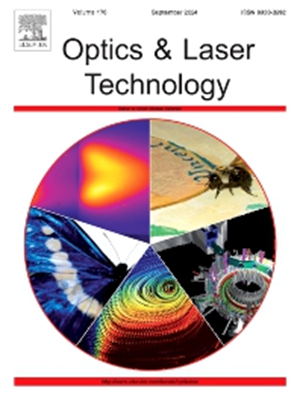In-Situ monitoring of porosity based on static and dynamic molten pool features in laser powder bed fusion
IF 4.6
2区 物理与天体物理
Q1 OPTICS
引用次数: 0
Abstract
Porosity is one of the most serious defects for laser powder bed fusion (LPBF) which is a promising metal additive manufacturing (AM) technique. Reducing porosity is essential to improve the mechanical properties of parts in high-end applications. While existing research primarily focuses on static molten pool features, such as size and shape, these methods overlook critical local details, leading to imprecise porosity monitoring. To address this gap, this study proposes a novel attention-based method for in-situ monitoring of porosity (AMNet) from hybrid static and dynamic features (also referred to as motion features) extracted from the molten pool. Dynamic or motion features represent the molten pool by computing the distance from its edge to the centroid in the image. In the proposed AMNet, we adopt a self-attention mechanism to extract representative features from static and motion features separately. Furthermore, cross-attention is introduced to fuse two kinds of features in the latent space for porosity detection. To verify the effectiveness of AMNet, we collect a dataset consisting of molten pool and porosity data with three categories. The proposed AMNet achieves superior performance with an accuracy of 99.4 % on our dataset. Even 92 % accuracy is obtained with only 20 % of the training set by AMNet. The inference time of AMNet, averaging around 6.25 ms per sample has the potential to enhance closed-loop quality control systems by providing valuable real-time feedback. These results demonstrate the effectiveness and efficiency of the proposed method in porosity detection during LPBF.
求助全文
约1分钟内获得全文
求助全文
来源期刊
CiteScore
8.50
自引率
10.00%
发文量
1060
审稿时长
3.4 months
期刊介绍:
Optics & Laser Technology aims to provide a vehicle for the publication of a broad range of high quality research and review papers in those fields of scientific and engineering research appertaining to the development and application of the technology of optics and lasers. Papers describing original work in these areas are submitted to rigorous refereeing prior to acceptance for publication.
The scope of Optics & Laser Technology encompasses, but is not restricted to, the following areas:
•development in all types of lasers
•developments in optoelectronic devices and photonics
•developments in new photonics and optical concepts
•developments in conventional optics, optical instruments and components
•techniques of optical metrology, including interferometry and optical fibre sensors
•LIDAR and other non-contact optical measurement techniques, including optical methods in heat and fluid flow
•applications of lasers to materials processing, optical NDT display (including holography) and optical communication
•research and development in the field of laser safety including studies of hazards resulting from the applications of lasers (laser safety, hazards of laser fume)
•developments in optical computing and optical information processing
•developments in new optical materials
•developments in new optical characterization methods and techniques
•developments in quantum optics
•developments in light assisted micro and nanofabrication methods and techniques
•developments in nanophotonics and biophotonics
•developments in imaging processing and systems

 求助内容:
求助内容: 应助结果提醒方式:
应助结果提醒方式:


